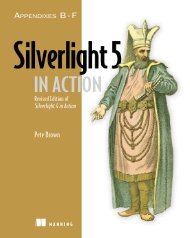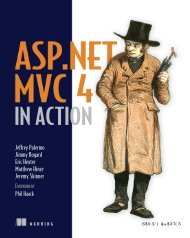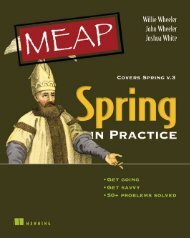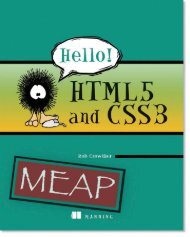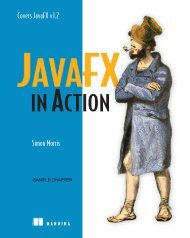jQuery in Action - Manning Publications
jQuery in Action - Manning Publications
jQuery in Action - Manning Publications
Create successful ePaper yourself
Turn your PDF publications into a flip-book with our unique Google optimized e-Paper software.
16 CHAPTER 1 Introduc<strong>in</strong>g <strong>jQuery</strong><br />
Before we dive <strong>in</strong>to us<strong>in</strong>g <strong>jQuery</strong> to br<strong>in</strong>g life to our pages, you may be wonder<strong>in</strong>g<br />
if we’re go<strong>in</strong>g to be able to use <strong>jQuery</strong> with Prototype or other libraries that also use<br />
the $ shortcut. The next section reveals the answer to this question.<br />
1.3.6 Us<strong>in</strong>g <strong>jQuery</strong> with other libraries<br />
Even though <strong>jQuery</strong> provides a set of powerful tools that will meet most of our needs,<br />
there may be times when a page requires that multiple JavaScript libraries be<br />
employed. This situation could come about when we’re transition<strong>in</strong>g an application<br />
from a previously employed library to <strong>jQuery</strong>, or we might want to use both <strong>jQuery</strong><br />
and another library on our pages.<br />
The <strong>jQuery</strong> team, clearly reveal<strong>in</strong>g their focus on meet<strong>in</strong>g the needs of their user<br />
community rather than any desire to lock out other libraries, have made provisions<br />
for allow<strong>in</strong>g <strong>jQuery</strong> to cohabitate with other libraries.<br />
First, they’ve followed best-practice guidel<strong>in</strong>es and have avoided pollut<strong>in</strong>g the<br />
global namespace with a slew of identifiers that might <strong>in</strong>terfere not only with other<br />
libraries, but also with names we might want to use on our pages. The identifier<br />
<strong>jQuery</strong> and its alias $ are the limit of <strong>jQuery</strong>’s <strong>in</strong>cursion <strong>in</strong>to the global namespace.<br />
Def<strong>in</strong><strong>in</strong>g the utility functions that we referred to <strong>in</strong> section 1.3.2 as part of the <strong>jQuery</strong><br />
namespace is a good example of the care taken <strong>in</strong> this regard.<br />
Although it’s unlikely that any other library would have a good reason to def<strong>in</strong>e a<br />
global identifier named <strong>jQuery</strong>, there’s that convenient but, <strong>in</strong> this particular case,<br />
pesky $ alias. Other JavaScript libraries, most notably the Prototype library, use the $<br />
name for their own purposes. And because the usage of the $ name <strong>in</strong> that library is<br />
key to its operation, this creates a serious conflict.<br />
The thoughtful <strong>jQuery</strong> authors have provided a means to remove this conflict with<br />
a utility function appropriately named noConflict(). Anytime after the conflict<strong>in</strong>g<br />
libraries have been loaded, a call to<br />
<strong>jQuery</strong>.noConflict();<br />
will revert the mean<strong>in</strong>g of $ to that def<strong>in</strong>ed by the non-<strong>jQuery</strong> library.<br />
We’ll cover the nuances of us<strong>in</strong>g this utility function <strong>in</strong> chapter 7.<br />
1.4 Summary<br />
We’ve covered a great deal of material <strong>in</strong> this whirlw<strong>in</strong>d <strong>in</strong>troduction to <strong>jQuery</strong>, <strong>in</strong><br />
preparation for div<strong>in</strong>g <strong>in</strong>to us<strong>in</strong>g <strong>jQuery</strong> to quickly and easily enable the development<br />
of next-generation web applications.<br />
<strong>jQuery</strong> is generally useful for any page that needs to perform anyth<strong>in</strong>g but the<br />
most trivial of JavaScript operations, but it’s also strongly focused on enabl<strong>in</strong>g page<br />
authors to employ the concept of Unobtrusive JavaScript with<strong>in</strong> their pages. With this<br />
approach, behavior is separated from structure <strong>in</strong> the same way that CSS separates<br />
style from structure, achiev<strong>in</strong>g better page organization and <strong>in</strong>creased code versatility.<br />
Despite the fact that <strong>jQuery</strong> <strong>in</strong>troduces only two new names <strong>in</strong> the JavaScript<br />
namespace—the self-named <strong>jQuery</strong> function and its $ alias—the library provides a



